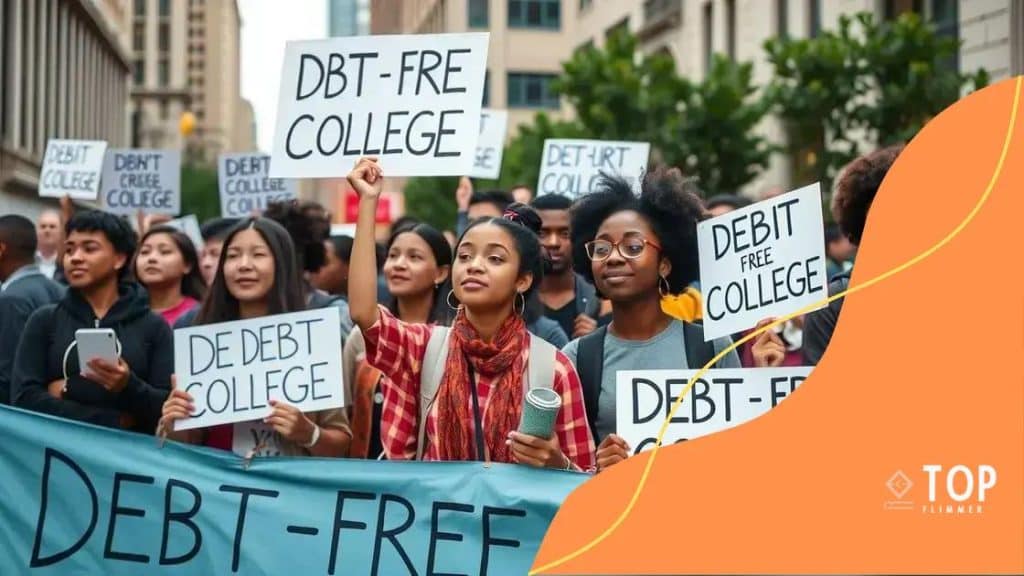Student protests for debt-free college spark nationwide debate

Student protests for debt-free college aim to eliminate tuition fees, forgive student loans, and ensure equitable access to higher education, fostering a more inclusive and economically stable society.
Student protests for debt-free college are gaining momentum across the country, as young voices demand a transformative change in education. Have you ever considered how student debt affects not only individual lives but also the entire economy? In this article, we’ll dive into the current landscape of these protests and the implications of a debt-free future.
The rise of student debt in America
The rise of student debt in America has become a significant concern for many. With college tuition skyrocketing in recent years, students are left with mounting financial burdens that can last for decades. Understanding the roots of this crisis is crucial to finding a solution.
The Impact of Student Debt
More than 45 million borrowers currently owe a combined total of over $1.7 trillion. This staggering figure impacts not only individuals but the entire economy as well. A large portion of this debt comes from federal loans, which are easier to obtain than private loans.
Key Factors Contributing to Rising Debt
- Increased college tuition rates
- Stagnant wages for graduates
- Limited access to scholarships and grants
- Growing reliance on loans to fund education
As college expenses continue to grow, many students are forced to take on additional debt even before they begin their careers. This can lead to challenges in financial stability and can affect life choices, such as home ownership or starting a family.
The burden of debt also disproportionately affects disadvantaged groups, creating a cycle of inequality. Many students look to part-time jobs to help with expenses, but these jobs often don’t cover the full cost of living and tuition, leading to even more borrowing.
The Long-Term Effects
Accumulating significant student debt can lead to a variety of long-term effects. Graduates may postpone major life decisions, and many struggle to make loan repayments while managing other financial responsibilities. Additionally, high levels of debt can deter new graduates from pursuing entrepreneurial aspirations or investing in further education.
Addressing the rise of student debt is essential for ensuring a healthier economy and a more equitable education system. As awareness grows about this crisis, so too does the discussion about potential reforms.
Key demands of student protesters
The key demands of student protesters reflect a growing desire for change in the higher education system. Many students are speaking out and advocating for their rights, pushing for reforms that can ease the burden of debt and make college more accessible.
Major Demands
Students across the nation are uniting around several core issues. These demands seek not only to address financial concerns but also to create a more equitable education system.
- Tuition-free college for all
- Student loan debt forgiveness
- Increased funding for public universities
- Comprehensive mental health services on campuses
Many protesters believe that making college tuition-free would significantly ease the financial strain on students and families. This demand is rooted in the belief that education should be a right, not a privilege. By eliminating tuition, students could focus more on their studies and less on accumulating debt.
Another critical area of focus is the forgiveness of existing student loans. With millions of borrowers struggling to repay debts, advocates argue that loan forgiveness would provide much-needed relief and allow graduates to invest in their futures. Additionally, increased funding for public universities is essential. This funding would help enhance educational quality, provide resources, and lower tuition costs overall.
Support for Mental Health
Beyond financial demands, students are also calling for better mental health services on campuses. The stress associated with both academic pressures and financial burdens can take a toll on students’ well-being. Providing accessible mental health resources is crucial for supporting students as they navigate their college experience.
Overall, the key demands of student protesters highlight a collective push for more equitable and accessible education. These voices are vital in shaping the future of higher education policy and determining how institutions respond to the needs of students.
Impact of debt-free college on society

The impact of debt-free college on society could be transformative. Removing financial barriers to education can have widespread benefits for individuals and the community as a whole. By ensuring that higher education is accessible, we can promote a healthier, more educated society.
Economic Benefits
One major impact of debt-free college is the potential for economic growth. Graduates without debt are more likely to invest in their future, including buying homes, starting businesses, and contributing to the economy. This leads to a more dynamic economy overall, as spending increases.
- Increased purchasing power for graduates
- More entrepreneurship and innovation
- Greater investments in local communities
When graduates feel less financial pressure, they are more willing to take risks, such as launching new businesses. This entrepreneurial spirit can lead to job creation, benefiting the economy at large.
Social Equality
Another significant impact relates to social equality. Debt-free college can help bridge the gap between different socioeconomic groups. By making college accessible to all, we ensure that everyone, regardless of their background, has the chance to pursue higher education and improve their circumstances.
Providing equal access to education can lead to a more inclusive society. When more individuals from diverse backgrounds graduate, they bring unique perspectives and ideas, enriching the workplace and community discussions.
Mental Health Improvements
Access to a debt-free education can also positively influence mental health. Many students experience significant stress due to financial pressures. Reducing this stress can lead to better academic performance and overall well-being.
With less anxiety about finances, students can focus on their education and personal development. They are likely to achieve higher rates of graduation and satisfaction with their college experience.
The long-term effects of debt-free college on society are profound. As we consider reforms in education, understanding these potential benefits can guide discussions and inspire action.
Success stories from debt-free college advocates
Success stories from debt-free college advocates illustrate the positive change this movement can bring to individuals and communities. These stories inspire hope and demonstrate how eliminating tuition fees can transform lives and futures.
Empowering Individuals
Many individuals have experienced firsthand the benefits of a debt-free education. For example, graduates who enter the workforce without loans are able to focus on their careers from day one. They can invest their earnings in homes, savings, and businesses. This empowerment creates a ripple effect, positively influencing their families and communities.
Overcoming Barriers
Advocates for debt-free college often share stories of those who overcame significant obstacles. Some students come from low-income backgrounds where higher education seemed out of reach due to the high costs. With the potential for tuition-free options, many have achieved what once felt impossible. They are now attending college and pursuing their dreams without the weight of debt holding them back.
These inspiring stories highlight resilience and determination. They show that when financial worries are lifted, students can thrive academically and personally.
Community Impact
Universities that have embraced debt-free college initiatives report strong community growth. Local economies benefit when graduates contribute positively after finishing their education. Rising employment rates and increased customer spending foster thriving neighborhoods.
For instance, cities that have adopted tuition-free programs see a boost in population as more families move in, seeking a vibrant community with better educational opportunities.
These success stories from debt-free college advocates serve as powerful examples of how changing the educational landscape can lead to brighter futures for individuals and society at large. They inspire new movements and highlight the importance of making education accessible and equitable for everyone.
How to support student protests effectively
Supporting student protests effectively requires a deep understanding of the issues at hand and a commitment to advocating for positive change. Many individuals and groups want to get involved but may not know the best ways to contribute. Here are some ways to support the cause.
Be Informed
Understanding the key issues behind the protests is crucial. Student protest movements often focus on issues like college affordability, mental health resources, and educational equity. Keep up with the news, read articles, and listen to students’ perspectives to stay informed about their demands and challenges.
Participate in Events
Joining protests, rallies, or informational meetings shows solidarity with students. Your presence can make a difference. When you actively participate, you demonstrate that these issues matter not just to students, but to the broader community. Many protests welcome supporters who can help amplify their messages.
- Attend rallies and marches
- Engage in local discussions and forums
- Share events on social media to reach a wider audience
- Volunteer your time to help organize
Many protests also have specific needs. This could include providing food and water, helping with logistics, or offering a space for meetings. Always check in with student leaders about how you can assist in meaningful ways.
Utilize Social Media
Social media is a powerful tool for advocacy. By sharing posts from student activists, using relevant hashtags, and spreading the word about student protests, you can help draw attention to the cause. Highlight key messages and share personal stories that resonate with others, encouraging more people to get involved.
Student protests thrive on community support, and every voice matters. Utilizing your platforms can spark conversations and motivate others to lend their support.
Being part of a supportive network also means listening to students’ experiences and amplifying their voices. Acknowledge their struggles and amplify their calls for change. Young people need allies who understand their challenges and are committed to fighting for a better future.
Supporting student protests effectively is about merging your voice with theirs, partnering in advocacy, and standing together for justice and equality. Every small effort counts in creating a significant impact.
FAQ – Student Protests and Debt-Free College
What are the main goals of student protests for debt-free college?
The main goals include achieving tuition-free education, forgiving existing student loans, and increasing funding for public universities.
How can I effectively support student protests?
You can support by staying informed, attending rallies, utilizing social media to amplify messages, and listening to student experiences.
What impact does debt-free college have on society?
Debt-free college can boost economic growth, promote social equality, and improve the mental health of students by reducing financial stress.
Why is it important to advocate for debt-free college?
Advocating for debt-free college ensures equal access to education for all, reduces financial burdens on graduates, and fosters a more educated and productive society.






